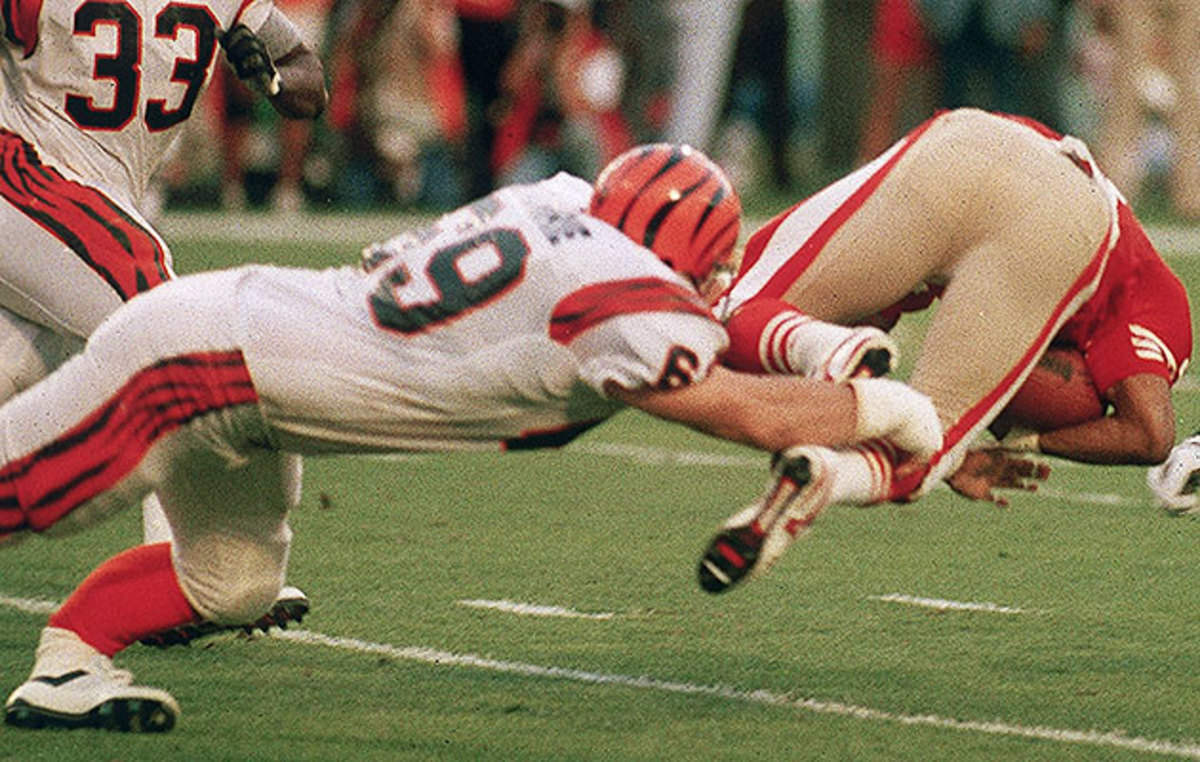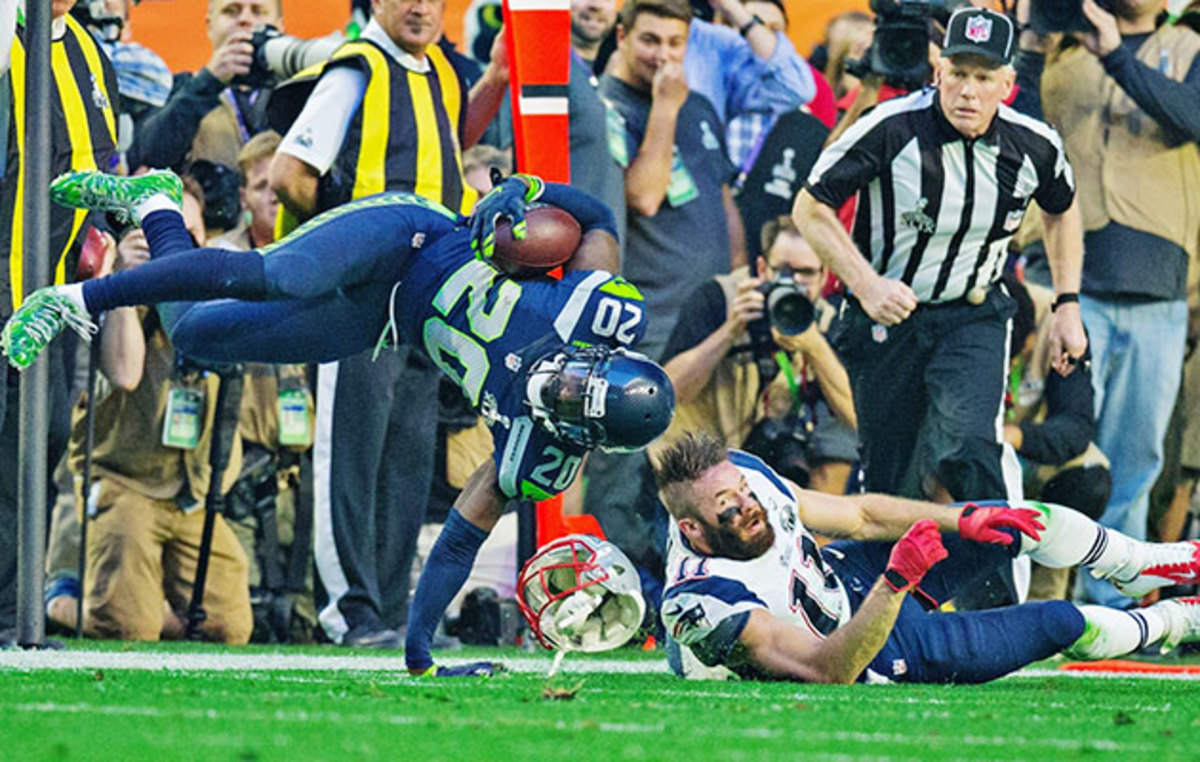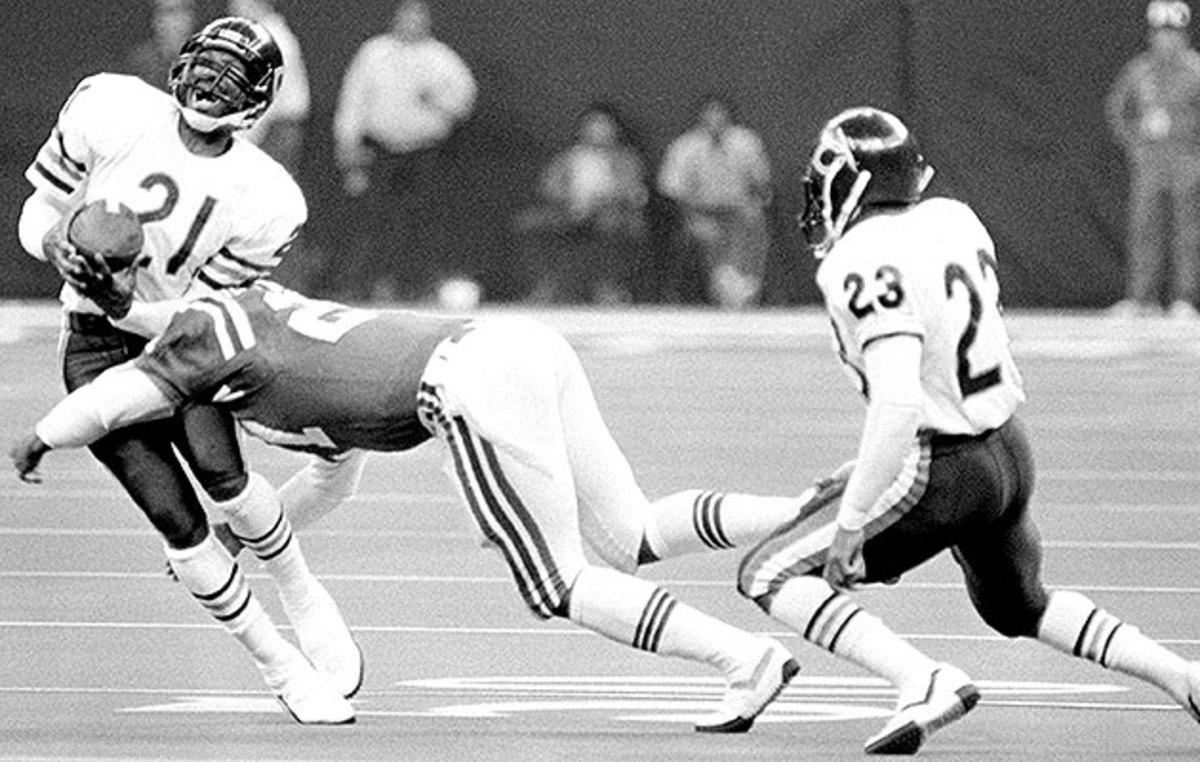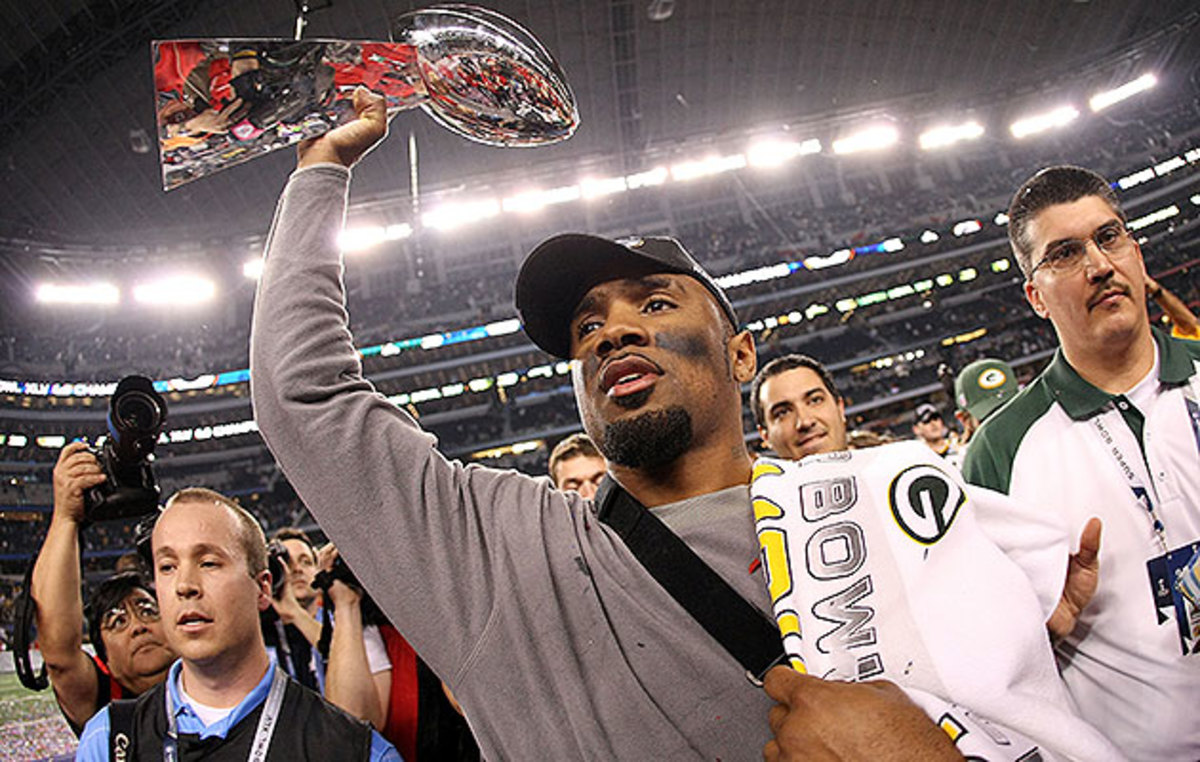Super Bowl injuries: What it’s like to get hurt in the game of your life

As part of our countdown to Super Bowl 50, SI.com is rolling out a series focusing on the overlooked, forgotten or just plain strange history of football's biggest game. From commercials to Super Bowl parties, we'll cover it all, with new stories published every week here.
Tim Krumrie was a stubborn player on the field. He was not going to be blocked. And now, inside the Bengals’ locker room on the very last day of the 1988 season, he was being darn stubborn, too.
His left leg felt like someone was trying to yank it off—but he refused to go to the hospital. He refused to take painkillers.
Anyone old enough to watch Super Bowl XXIII probably remembers what happened to Krumrie. Midway through the first quarter, the 49ers were backed up against their own goal line, and Krumrie, as was typical for the All-Pro Cincinnati nose tackle, was being double-teamed at the line of scrimmage.
Not inclined to let San Francisco running back Roger Craig slip past him, Krumrie managed to shed his blockers, and he stuck out his left leg and left arm as Craig rounded the corner. That’s when it happened: His left ankle torqued underneath the full weight of his 274-pound frame. As he rolled over, he had no control of his left leg, which flailed freely in the air.
“Oh blank, I really messed up now. Blank, blank, blank,” the self-censoring Krumrie recalls thinking. “My left foot was facing the wrong way.”
Bengals coach Sam Wyche clasped his head in his hands, then jogged out onto the field. The injury was so severe that Cincy’s medical staff felt compelled to inflate an air cast, stabilizing the leg for a ride to the locker room. After a vivid replay, NBC broadcaster Merlin Olsen told 82 million viewers across America, “I don’t think we want to see that one again.”
The results of the subsequent X-ray were even more gruesome. Krumrie had four breaks in his lower left leg: two in the tibia, one in the fibula and one in his ankle. His was a compound, segmented fracture, which meant, at the risk of sounding too graphic, that his foot was attached only by his skin. Cincinnati’s defense had lost its fulcrum just seven snaps into the biggest game of the season.
Krumrie felt humbled and helpless. He didn’t want his Super Bowl experience to be over just yet. So he stayed in the locker room at Joe Robbie Stadium as long as he could, watching the game on TV and ratcheting down the painkillers because they might cloud his memory.
Whether he was playing or not, Krumrie decided, “I just wanted to remember the game.”

There is an involuntary fraternity of professional football players who share this bittersweet experience: Making it to the Super Bowl, only to suffer an injury that forces them out of the biggest game of their lives.
Krumrie’s injury, by virtue of its queasiness, is perhaps the best known. But just a few plays earlier in the same game, 49ers left tackle Steve Wallace (himself a future All-Pro) was taken off the field in a wheelchair after Joe Montana crashed into his left leg. The 1985 Bears, one of the greatest title-winning teams of all time, lost starting cornerback Leslie Frazier in the second quarter of Super Bowl XX, when he tore his ACL on a trick punt return.
In more recent history, future Hall of Famer Charles Woodson snapped his collarbone in the first half of Super Bowl XLV while playing for the Packers. Addressing his teammates at halftime, all he could get out was, “You know how bad I want this, guys. . . .” The Giants were doubly unlucky a year later: They lost two tight ends, both to ACL tears, in Super Bowl XLVI. NBC cameras even caught the agonizing moment on the sideline when Jake Ballard was testing his knee to try to return, and collapsed in pain.
The SI story that wasn't: Covering Super Bowl XXIX with the Hobo King
And then there’s Seahawks nickelback Jeremy Lane, who memorably intercepted Tom Brady in Seattle’s end zone in the first quarter of Super Bowl XLIX last February—but suffered a compound fracture of his left arm and tore his ACL while making the return. Lane is still uncomfortable reliving his experience and declined to talk about it again. He’s shared the details only once publicly, telling Seattle reporters months later that he underwent arm surgery during the game—and woke up just in time for the wild climax, when the Seahawks were on the Patriots’ one-yard line.
There’s a quirkiness to these players’ stories, the small details reinforcing their unluckiness in both time and circumstance. As the saying goes, the injury rate in the NFL is 100%—but only a small number of players know the misfortune of having it happen on the sport’s grandest stage.

First and foremost, Wallace remembers the sounds he heard. Three pops—pow, pow, pow. Someone just got seriously injured, he thought to himself. It wasn’t until he tried to stand up, and failed, that he realized: He was that someone.
The 1988 season was Wallace’s first as a full-time starter. Bill Walsh, the legendary 49ers coach, had trusted him, and Wallace (who you may remember for the rubber cushioning he wore atop his helmet, giving the appearance of a double dome) wanted to show the world in his first Super Bowl that he could protect Montana’s blind side. That’s precisely what he was doing on the third play of the game, the first pass play called, a short 10-yard toss to the running back, Craig.
While Wallace was engaged in his block, pressure came from a rusher up the middle. Montana was knocked backwards and, fatefully, landed on his teammate’s lower leg. Each of the pops Wallace heard represented damage to his own body: his fibula breaking down near his ankle, and the surrounding ligaments tearing. Wallace rolled over in pain and slammed his head on the turf in frustration—once, twice, three times.
“My gosh, that guy is gone already?” Wallace remembers hearing a fan ask as he was taken off the field. The X-ray confirmed it. “You want to hear the doctors say, ‘OK, this is the Super Bowl; let’s get your butt back out there,’ ” Wallace says. “But they said, ‘You’re finished.’ And that’s when it got bad, the frustration of, I finally made it, I finally got my name called in a Super Bowl—and I won’t be playing any longer.”
The man behind the legend: McGee’s story goes well beyond SB hangover
Wallace reached the locker room just in time to see Krumrie’s injury on television. It could have been worse, he realized. Not long after, 49ers owner Eddie DeBartolo Jr. came down to check on him. The two men ended up watching the rest of the game together on the locker room TV alongside DeBartolo’s bodyguards.
Wallace, who had been part of the 1983 Auburn team that many felt was robbed of a national title and who now was playing on a 49ers team that had won two titles in the five years before he arrived, told DeBartolo he worried he was a bad-luck charm: the left tackle who got injured on the first drive and torpedoed his team’s chance at another ring.
“No, Stevie,” Wallace remembers DeBartolo telling him, “we’re going to do this. We have the greatest quarterback ever.”
DeBartolo shook the massive lineman in excitement while Montana led a brilliant fourth-quarter drive to win the game on a 10-yard touchdown pass to John Taylor. When his teammates rushed into the locker room, Wallace joined the celebration, hopping around on crutches.
“. . . And remember Steve Wallace!” safety Ronnie Lott added when the team broke down its huddle.
Wallace’s surgery required that a 2 1⁄2-inch screw be drilled across his ankle, along with five other screws and a plate. He spent the spring of 1989 laboring in the 49ers’ weight room, hoping to get healthy for next season, and every time Montana passed him in there, the three-time Super Bowl champion confessed his guilt for the unlucky fall. “Stevie,” Montana would say, “I am so sorry.”
Not that it was Montana’s fault, of course.
“Hey, if you’re going to have a broken ankle,” Wallace says, “then hopefully Joe Montana had something to do with it.”

The Bears had practiced the trick play every week of their 1985 season. Their return man would catch a punt, then he’d flip it to Frazier running around on the reverse. “If you ever call that in a game,” Frazier would tell special teams coordinator Steve Kazor, “I’m going to score.”
They never called it—Frazier hadn’t returned punts since he became a starting cornerback—until Super Bowl XX, in January 1986 . The 26-year-old lit up when he heard the call in the huddle. . . . But then things went terribly wrong. For starters, return man Keith Ortego mistakenly called for a fair catch, meaning that the Patriots’ punt couldn’t be returned. But Ortego handed the ball to Frazier anyway, and as Frazier tried to plant and burst upfield, his left foot got caught awkwardly in the Superdome turf.
“They told me what they thought it was, but I didn’t believe it—I didn’t think I had torn my ligaments like they said,” Frazier recalls. “I thought I would be able to come back and play.”
So too did Ballard, who 26 years later was running a route against New England linebacker Brandon Spikes in the fourth quarter of Super Bowl XLVI when he fell to the turf, clutching his left knee. He’s spent the subsequent four years replaying what happened next. The Giants’ medical staff came onto the field and did a knee stability test. He says they told him it was likely an injury to his meniscus, the shock absorber in the knee, rather than his ACL. You can play with that, and Ballard was going to try.
“It was the Super Bowl, the fourth quarter, we were making a drive, and we were losing,” Ballard says. “I wasn’t going to sit out of a game with a meniscus injury.”
The man behind the legend: McGee’s story goes well beyond SB hangover
New York’s medical staff taped up the knee on the sideline, then had Ballard test it by trying to run and stop. That’s when the leg buckled beneath him, the searing pain displayed all over his face as he fell to the ground. To this day, no one can tell Ballard for sure whether that’s when he tore his ACL, or if he actually tore it on the field (and by running on the sideline with an unstable knee, had his thigh bone hit against the top of his shin bone, causing the cartilage damage that complicated his eventual rehab). He believes it’s the latter.
Ballard spent the game’s final minutes back in the training room, without access to TV, radio or phone service. When he heard raucous cheers (for the Giants’ game-winning touchdown), he started hopping down the hallway on his good leg to see what had happened. He jumped in a golf cart with one of the team doctors, and the two drove out to the field just in time to see Tom Brady’s final Hail Mary batted down.
The celebration, though, was bittersweet. Ballard sat on a cooler with his parents, wearing a Super Bowl T-shirt and hat. He didn’t get to climb the podium, didn’t get to hold the Lombardi Trophy—and he didn’t know how seriously his knee was injured. “The fact that it happened to me in the Super Bowl,” Ballard says, “I was dumbfounded and kind of lost.” The next day, the Giants flew home and Ballard went straight from the airport to Manhattan’s Hospital For Special Surgery, where he got the news: ACL, cartilage damage, etc. He needed microfracture surgery.
That was the beginning of the end of Ballard’s NFL career. It was more than eight months before the tight end could run again, and he didn’t play in another competitive game until nearly two years later, signing with the Cardinals midway through the 2013 season. Like many players who’ve endured microfracture surgery, he wasn’t the same player—his knee was sore and kept swelling, and he couldn’t block or run like he had before. He retired in the summer of ‘14.
For Frazier, the trick punt return was precisely the last play of his NFL career. Walking off the field at halftime of that game, the Bears’ “Super Bowl Shuffle” played on the Superdome jumbotron, and Frazier remembers thinking how that 1985 Chicago team had captivated fans across the country. But once he got in the locker room, team doctors told him to change into street clothes. He didn’t get to participate in the victory parade back in Chicago the next day, either—it was cold and icy, too risky with his injured knee.
Frazier underwent reconstructive knee surgery a few days later, a procedure that was far more invasive in those days. He remembers his surgeon telling him that in a year or two, with the advent of the arthroscope, he would have had a much easier recovery. But Frazier’s open procedure required his leg to be in a cast for six weeks.
He was still trying to return 18 months later when Bears coach Mike Ditka summoned Frazier to his dorm room at the beginning of the team’s 1987 training camp. Chicago’s owner, GM, head of personnel, team doctor and trainer were all there to break the news: They couldn’t pass Frazier on the physical. The scar tissue in his knee never allowed him to regain his range of motion.
“To play in the biggest game in your career, the game that every kid in America dreams about playing in, and for that to be your last game? It was really hard,” says Frazier, now the defensive coordinator for the Buccaneers. “But being a part of that team was a very proud moment. And I don’t think I would have gotten into coaching were it not for that injury. So I wouldn’t change a thing.”

Two hours after the confetti fell on Super Bowl XLV, Woodson was the last player left in the winners’ locker room. Finally, the Packers’ DB asked for help in putting on his jacket from two SPORTS ILLUSTRATED reporters, Peter King and Tim Layden. His collarbone, broken all the way through, was the price of a Super Bowl ring.
On the play when he was hurt, Woodson had been playing cornerback on the boundary. With teammate Sam Shields out, he drew the assignment of covering Steelers speedster Mike Wallace. The only way he believed he could break up Ben Roethlisberger’s downfield shot was to dive forward, fully extending his body toward the ball.
He tried to go on the next play, but he knew something was wrong. When an X-ray showed that a piece of his collarbone had separated from the rest, Woodson knew his Super Bowl was over. That day, he said he cried more than he could ever remember crying. His emotional halftime speech, the one he couldn’t finish, became the stuff of legend. And his teammates finished the job for him.
That would be the lone Super Bowl ring for Woodson, who played the final game of his career earlier this month. Steve Wallace, on the other hand, had the good fortune of playing in the Big Game two more times (and finishing both) as part of the 49ers’ dynasty years. The season after his early exit, when San Francisco triumphed in a muddy throwdown against the Rams in the NFC Championship Game, Wallace was so elated to get a second chance to play in the Super Bowl that he jumped in a puddle and made a mud angel in the middle of Candlestick Park.
The cost of the physical sacrifice required to play for a championship depends on your perspective. For Ballard, retired from the game at age 28, the pain is still fresh—literally. He can’t even play pick-up basketball without suffering pain in his knee. He watches college football, but he hasn’t been able to watch much of the NFL, because he wants to be out there.
“When I’m 50 and I’m looking back and I have a Super Bowl ring, and I couldn’t be playing football anyway, then it’s awesome and I’m glad I have this ring,” says Ballard, who now works as a real estate agent in Columbus, Ohio. “But right now? I still want to be playing. That’s the tough part.”
As for Krumrie, the Bengals’ team doctors finally overruled him and took him to the hospital late in the fourth quarter of Super Bowl XIII. They couldn’t risk getting stuck in stadium traffic with a patient who might go into shock. The next day, Krumrie was strapped to a stretcher and laid on top of an airline catering truck, which was hoisted up to a side door of his team’s plane. Back in Cincinnati, doctors put his left leg together with the help of a 15-inch titanium rod.
Krumrie needed both knees replaced about two years ago, and his surgeon planned to take out that rod. But like Krumrie, it was stubborn, didn’t budge, and so it stayed in. He didn’t really mind: His only Super Bowl had ended unceremoniously, but the rod is a badge of honor, of sorts.
“If you [had told me], ‘Tim, you’re going to the Super Bowl, and somewhere in that game you’re going to break your leg,’ I’d say, ‘Break it,’ ” Krumrie explains. “It’s that simple. I’m going to the Super Bowl. I’m going.”
